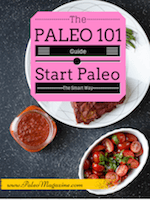3 Reasons This Seafood Is Your New Best Friend

Nori. Dulse. Gim.
Whatever you call it, seaweed is a nutritional powerhouse.
Although seaweed is eaten around the world, Japan is the country most commonly associated with seaweed consumption. In fact, recent research indicates that the average Japanese citizen’s gut bacteria is specifically adapted to be able to digest more seaweed than most other folks around the world.
Seaweed comes in multiple varieties, but we can break it down more simply into algae of 3 colors: green (Wakame), red (Dulse or Nori), and brown (Kombu).
Technically the term sea“weed” isn’t correct, because weeds are by definition plants that spread so rapidly they may damage the environment. However, seaweed is a crucial part of the marine scene—it provides both habitat and food for aquatic animals.
Some seaweeds are microscopic, while others are as big as trees and grow in forests at the bottom of the ocean. People have been using this plant for thousands of years; evidence from ancient Rome suggests that people used it to treat wounds and burns, and some signs point to Egyptians using this water plant as a treatment for breast cancer.
Science is rapidly proving that we should be hopping on the centuries-old seaweed bandwagon.
Why Eat Seaweed?
- It’s a natural anti-inflammatory. A study showed that green seaweed was effective in reducing joint inflammation in arthritic rats, and we it’s likely that we can trace this to the eicosapentanoic acid found in aquatic plants. An essential fatty acid, e. acid has been shown in many past studies to help heal inflammation. This means that seaweed may also play a big part in reducing heart disease and high blood pressure!
- It’s packed with vitamins and minerals. Vitamin A, vitamin C, and calcium are just some of the many nutrients you can find in this ocean plant. Vitamins A and C help keep your skin, muscle, and bodily tissues strong and healthy, while calcium not only strengthens bones and teeth but also helps your nerves send messages throughout your body.
- Iodine. Seaweed is one of the world’s richest sources of natural edible iodine; humans have a history of being so deficient in it that we’ve had to manually add it to our salt in order to make sure we get enough. Iodine is crucial for your thyroid, which needs the mineral in order to produce and control your hormones. Without enough iodine, your metabolism would get wacky, and if you’re deficient as a baby, studies show that you have a much greater chance of issues with brain development.
How Can I Eat Seaweed?
- Wrap it around some sushi. This is one of the most famous ways to eat seaweed, because the sushi itself is so customizable—wrap that nori (Japanese seaweed) around whatever sort of sushi roll you want! Check out our Paleo sushi recipe here.
- As an ingredient in soup. Try adding seaweed to bone broth for an extra dose of deliciousness. Or you can even create a soup where seaweed is the main ingredient—put some seaweed and shiitake mushrooms together and you’ve got a great veggie soup!
- As a substitute for salt. Seriously, try it. You can find dry seaweed at many stores, so just crush it up into flakes and use it as you would salt. The natural flavor of seaweed is inherently a little salty, and you’re not missing out on any iodine by making the switch!
- In an omelet. Try putting strips of seaweed in with your egg and mushrooms for an awesome breakfast! You can also do the egg + seaweed combo in a salad if you are so inclined.
- As a seaweed salad. Check out our simple Paleo seaweed salad recipe here.
Seaweed is versatile in its uses and packed with a huge variety of crucial nutrients, so it’s no wonder that cultures based around eating this plant have a tendency to live longer. Next time you’re at the store, be sure to grab some seaweed (dry or wet are both great!) and get creative with some recipes! You can find seaweed in most Asian food stores, although you’ll also find seaweed in Whole Foods and many other supermarkets now.
You can also purchase dried seaweed on Amazon here.

